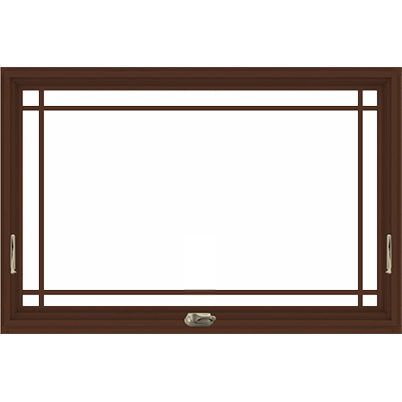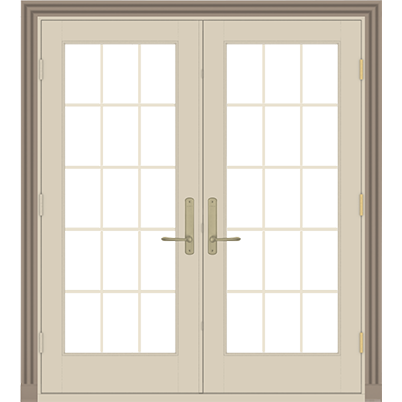Tips
Floor-to-ceiling windows
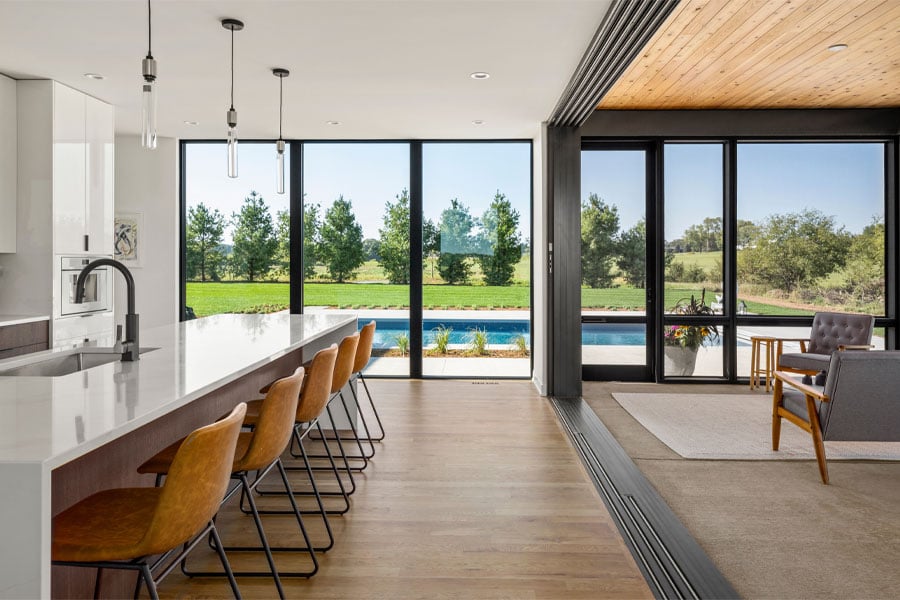
Floor-to-ceiling windows flood your home with light, make a modern interior/exterior statement, and help break down the barrier between indoors and out. In other words, they’re extremely impactful. Here’s how to incorporate them into your home and more answers to frequently asked questions.
What’s a floor-to-ceiling window?
As you might expect, a floor-to-ceiling window typically starts at the floor and extends to the ceiling. It's a look that can be created using various types of window, though usually a picture window (a window that doesn’t open) is used. Sometimes, several types of windows are combined to create a floor-to-ceiling effect. For example, large picture windows with smaller awning windows can give you the option of fresh air — more on this in the next section.
Where do floor-to-ceiling windows work best?
Of course, it’s your home, your rules. But if you’re looking for some ideas to get you started. Here are our top picks for places where floor-to-ceiling windows shine.
Modern homes
In a modern home, floor-to-ceiling windows are only natural. Not only is this style characterized by clean lines and lots of glass, but its boxy shape also makes tall rectangular windows a perfect fit. In the contemporary home below, the owners wanted to fill an entire wall with windows. To do this, they chose A-Series Picture and Awning Windows. The windows look sleek and contemporary and best of all they put the view on display — a hallmark of modern design.
Takeaway: Greater expanses of glass can be created by combining windows in large configurations. Ordering windows that are designed to be installed together can help avoid too much framing in between the windows. Talk to your builder if you’re interested in this option.
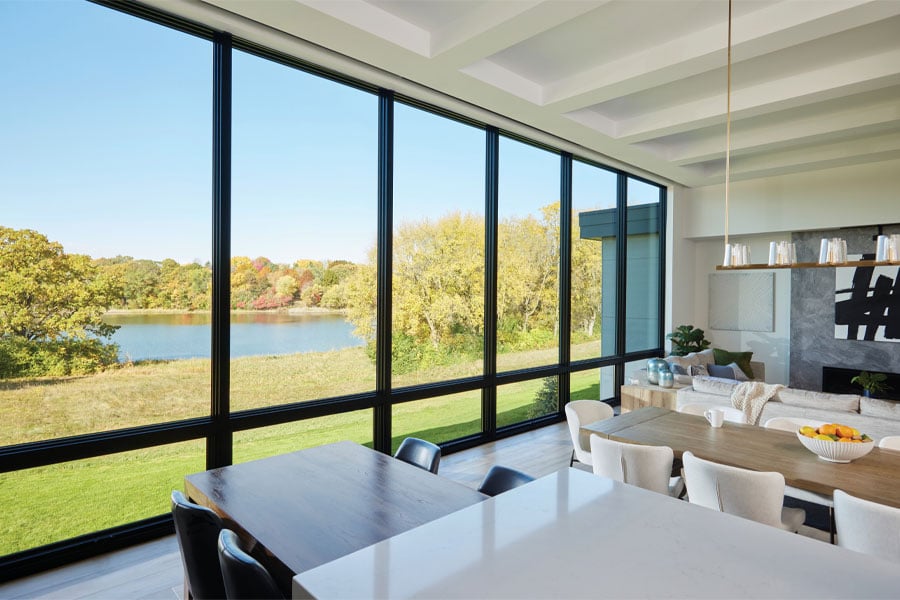
In this home, A-Series Picture and Awning Windows were used to create a window wall. The windows have more glass and less framing in between, because they were designed to be installed together in a large configuration.
Small spaces
In a small space, a floor-to-ceiling window is particularly impactful. It can expand the feeling of a room, like it does in Hilton Carter’s kitchen pictured below. When the plant and interior stylist went about remodeling his family’s home in Baltimore, he added this floor-to-ceiling window in an under-utilized corner of his kitchen where it not only brings in light, it also maximizes his indoor growing capabilities due to an in-floor planter.
Takeaway: You can make a small space feel bigger with a floor-to-ceiling window, so keep them in mind as a solution for dark corners, stair landings, and utilitarian rooms, like laundry rooms and offices.

Plant and interior stylist Hilton Carter chose an E-Series Picture Window for this corner of his kitchen where it helps bring in light and maximize his indoor growing capabilities.
Biophilic designs
In a home where you want to create a strong connection to nature, there’s no better window than floor to ceiling. When Sara Imhoff, AIA, and her partners at Imprint Architecture and Design LLC set out to design the home below for clients on the Minnesota prairie, they used a simple floor plan and floor-to-ceiling windows to bring natural light into rooms from multiple sides. “It’s a house that focuses on its exterior surroundings,” Imhoff said. “Everywhere you look, you’re looking out a window.”
Takeaway: Views and natural light are on full display when you use floor-to-ceiling windows to break down the barrier between indoors and outdoors.
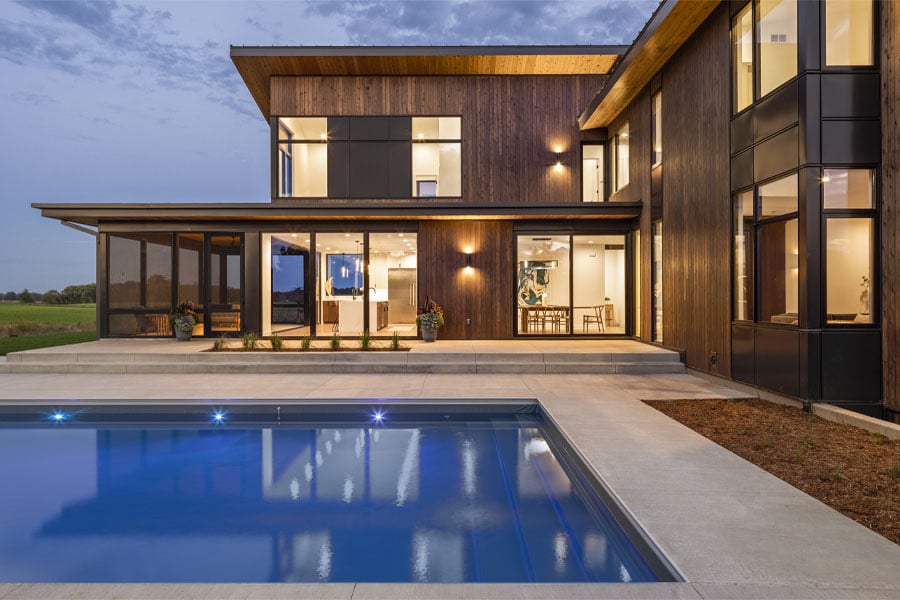
Floor-to-ceiling windows are a major feature of this contemporary home. They were chosen to make the most of the unobstructed light and views surrounding this prairie home. Architecture by Imprint Architecture & Design LLC.
Floor-to-ceiling windows and energy efficiency
If you’re wondering whether having such a large expanse of glass will make your home less efficient, here are some selections to consider.
- Window type: Picture windows don’t open (sometimes described as “fixed”) and that tends to make them efficient for a floor-to-ceiling opening. You can always combine them with a smaller-scale awning or other opening (or “operable”) window, if you want the option to bring in fresh air.
- Glass type: Triple-pane is our most efficient window glass option and it’s available on A-Series and E-Series windows. Consider these product lines when selecting floor-to-ceiling windows.
- Glass coating: Low-E coatings help reflect heat and keep your home more comfortable and energy efficient. Selecting the right coating (or coatings — they can be combined) for your climate will help.
Want more details? Check out How to pick out energy-efficient windows.
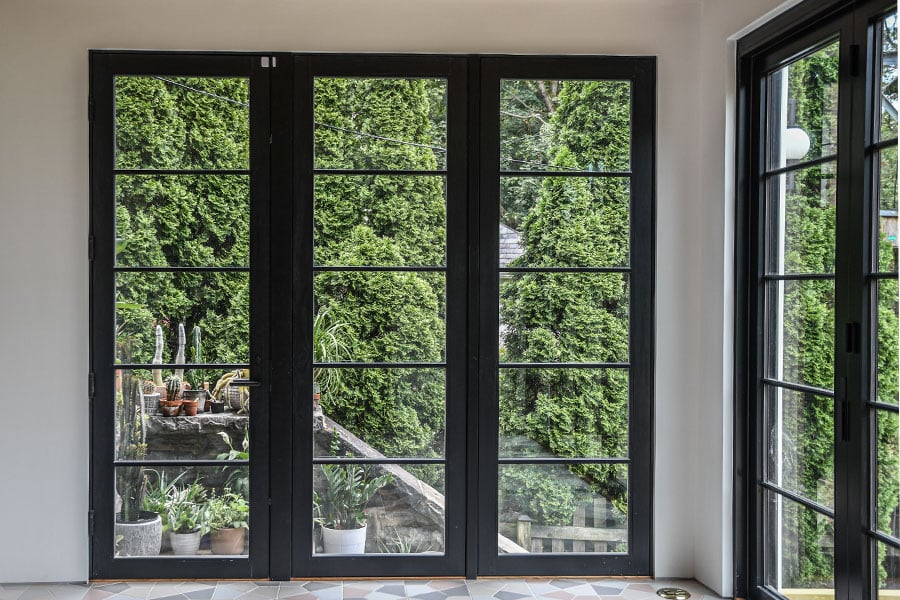
This room has a single-panel E-Series Hinged Door on the left and two floor-to-ceiling E-Series Picture Windows next to it. The door and windows match a Folding Outswing Door on the adjacent wall in color, grille style, and frame style.
Safety and floor-to-ceiling windows
When windows go all the way to the ground, safety glass is often recommended or required by code. Safety glass is like the glass used in a car’s windshield. It breaks into rounded chunks, rather than sharp shards. Even if your window seems out of reach, your local building code may require it, so it’s a good item to discuss with your builder. Find out more about our safety glass options. See your local code official for code requirements in your area.
Cleaning floor-to-ceiling windows
Like all windows, floor-to-ceiling windows should be cleaned regularly to make the most of your natural light and help keep your windows in good working condition. The height of a floor-to-ceiling window can add some complications when it comes to cleaning, here are some things to keep in mind.
- Exterior cleaning: If you select a picture window for your floor-to-ceiling window you will have to clean the outside of the glass from outside your home. If this is a concern, select a window that opens and is designed to be cleaned from inside the house, like a tilt-wash double-hung window or a casement window. By the way, casement windows can be up to 8 feet tall!
- Interior cleaning: If you have small children, sun-loving pets, or if your windows are in a high-use area, they might need to be cleaned more often than windows that don’t reach the floor. But a little regular attention can go a long way.
When you’re ready for an in-depth cleaning — we recommend doing this twice per year — follow our step-by-step window washing instructions
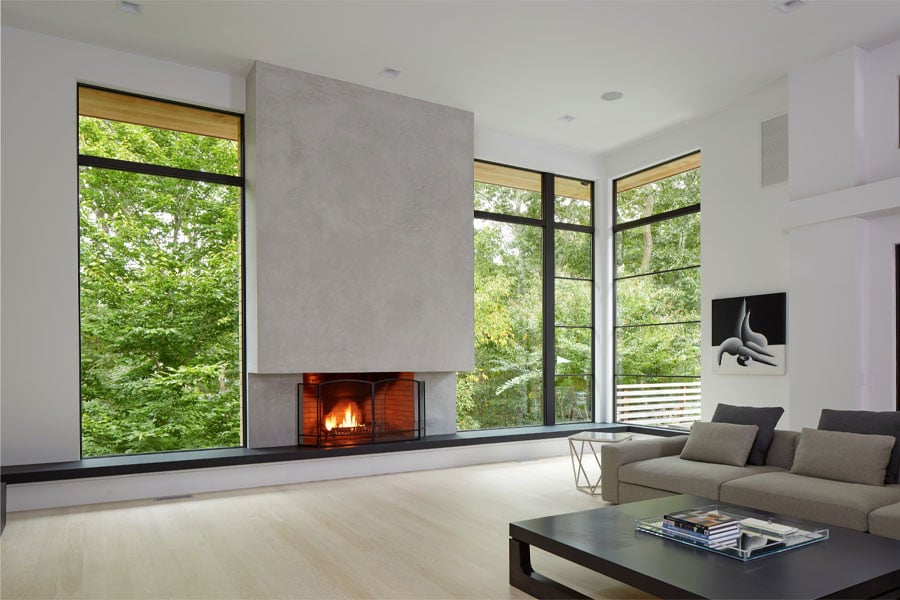
These E-Series picture windows create a floor-to-ceiling effect by starting from a low bench running around the perimeter of the room and reaching nearly to the ceiling. Transoms are joined to the larger picture windows below.
What do floor-to-ceiling windows cost?
We offer a range of window product lines with options that fit a variety of budgets. That said, it’s not just the windows themselves that must be considered when assessing the cost of floor-to-ceiling windows. The finishing, framing, and fit of windows is more challenging, as Imhoff points out. “A lot of times floor-to-ceiling windows might have to be custom made so they fit perfectly, and the drywallers have to do a fabulous job fitting the finishes into these details,” she said. If cost makes floor-to-ceiling windows prohibitive, there are other ways to create a similar effect.
Alternatives to floor-to-ceiling windows
If floor-to-ceiling windows won’t work in your home for one reason or another, but you still want to create a similar effect, consider the following options:
- Sliding glass doors with sidelights or a bi-parting sliding glass door — includes four panels: two center panels that slide to the left and right flanked by two fixed (non-moving) panels — are two glass-forward other options to consider. As a bonus, both will also give you access to the outdoors.
- Punched openings, or windows that frame a view the way a camera’s lens frames a landscape, bring the outdoors in while also offering privacy. And because they don’t go all the way to the floor, they’re easier to frame, install and trim around, according to Imhoff. A punched opening can be created with any type of window. What’s important is its placement and that’s where an architect can help.
- Pair a picture window with a transom (window above another window) to expand the feeling of the room and add more light. If you want the ability to add fresh air, our 400 Series Awning window with power operator is a particularly good choice. It can be opened with the touch of a button, so high placement isn’t a barrier to use.
Ready to explore all the types of windows?

